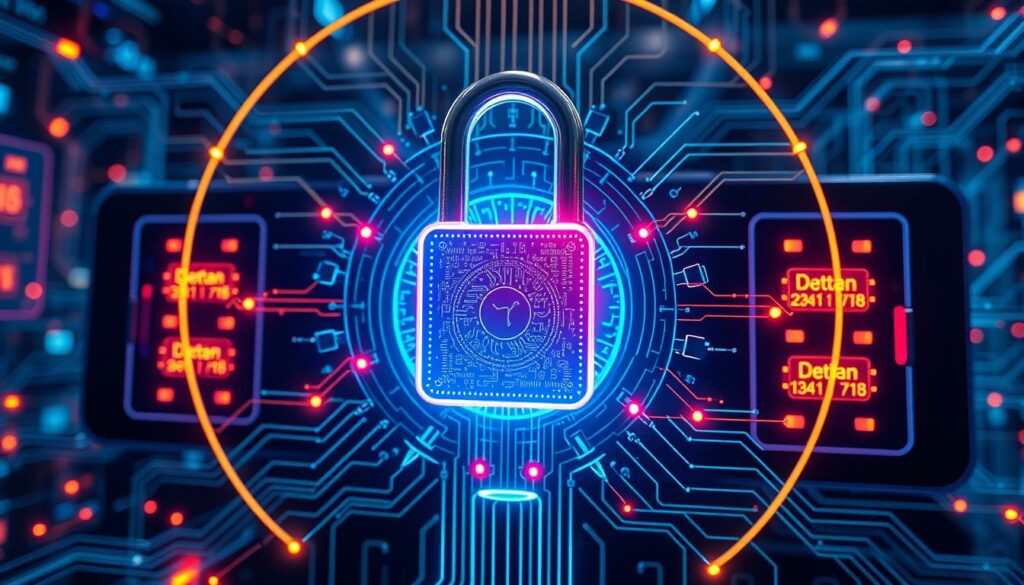Did you know that over 60% of companies plan to use blockchain by 2025? This change is big, moving beyond Bitcoin to change how we work. Blockchain is now a key part of a new era in IT, bringing better efficiency, security, and openness to many areas.
This article will show you how blockchain is changing industries. It’s not just for money anymore. You’ll see how decentralized IT can make things work better, keep data safe, and change old business ways.
New tools like Roam miners show how blockchain can offer rewards. With a $20 million ROAM token announced, Roam is more than a mining tool. It opens a new world in earning rewards. This shows blockchain’s power to drive innovation and change money systems.
Key Takeaways
- Blockchain technology is expected to be adopted by over 60% of enterprises by 2025, indicating its growing relevance beyond cryptocurrencies.
- Decentralized IT solutions present opportunities for increased security and efficiency in various sectors.
- Innovations in blockchain are paving the way for transformative applications in industries such as healthcare, supply chain management, and real estate.
- Roam’s mining ecosystem exemplifies how blockchain can create economic incentives for users through financial rewards and token economics.
- The value of blockchain extends beyond transactions, offering potential in enhancing business operations and securing data integrity.
Introduction to Blockchain Technology
The Introduction to Blockchain shows how a distributed ledger makes digital transactions more efficient and secure. This tech uses decentralization, where data is spread across many nodes, not just one. The Blockchain Basics start with blocks and chains, which are key to the tech. Each block has transactions, a timestamp, and a special code linking it to the last block, keeping everything secure and in order.
Consensus mechanisms are vital for checking transactions in blockchain. They make sure everyone on the network agrees on a transaction before it’s added. There are different types like Proof of Work and Proof of Stake, each with its own benefits and drawbacks. This way, decisions are made together, building trust among users.
Blockchain does more than just handle transactions. It brings more transparency, which helps many businesses. Companies like ABD Systems show how blockchain can be used in real life. ABD Systems started in 2009 and has been working in IT for over 13 years. They even launched the ABDS Token on the Ethereum blockchain, showing how blockchain helps businesses work better.
| Feature | Description |
|---|---|
| Decentralization | Data is stored across multiple nodes, reducing the risk of centralized control. |
| Transparency | All transactions are visible to network participants, enhancing accountability. |
| Security | Cryptographic hashing makes data tampering nearly impossible. |
| Consensus Mechanisms | Methods like Proof of Work and Proof of Stake validate transactions reliably. |
| Use Cases | Applications include payments, governance, and unlocking special features in platforms. |
Learning about this Technology Overview helps you understand the changing world of IT solutions with blockchain. Companies like ABD Systems use these technologies to work better and make the digital financial world safer and more open.
The Rise of Blockchain beyond Bitcoin
The Growth of Blockchain marks a big change in how we handle data and make transactions. Bitcoin was the first to grab the spotlight, showing the power of this tech. Now, blockchain is spreading its wings, reaching beyond just digital money.
Many industries are now using blockchain for big changes. It helps with things like making government work better and making voting safe. Using blockchain makes things more secure, cuts costs, and encourages new ideas. Companies see the big picture of Digital Transformation through blockchain, leading to big steps forward in tech.
More cryptocurrencies are popping up, adding to the Growth of Blockchain. Ethereum, for example, does more than just send money. It has smart contracts and apps that run on their own. This shows blockchain’s role is bigger than just Beyond Bitcoin, opening doors to new digital worlds.
As markets change, blockchain’s true impact is starting to show. It’s making supply chains better, helping with health data, and creating strong identity checks. This shows how blockchain is changing the game and pushing us forward.
Understanding Blockchain Technology
Learning about blockchain technology is key for those new to it. It’s a decentralized ledger that makes transactions secure and clear across different fields. By understanding how it works, you see its role in making digital interactions safer.
The Basics of Blockchain
Blockchain is all about a chain of blocks, each filled with data. It’s special because many copies of this data are spread out on different nodes, making it strong and clear. Each block links to the next with special codes, making it hard to change the chain. This is key to building trust in transactions.
Cryptography and Its Importance
Cryptography is crucial for blockchain security. It keeps transactions private, whole, and real. With these methods, only the right people can see the info. This protects each transaction and the whole blockchain from threats. You can look into jobs like becoming a Certified Bitcoin Expert™ to get better at handling cryptocurrency and blockchain. For more info, check out this resource.
Decentralization: A New Paradigm for IT
Decentralization in IT is changing how technology works. It moves away from old, centralized systems. This change makes systems more secure and reliable by reducing dependence on a single point of failure.
Using blockchain technology, companies can enjoy Blockchain Benefits. These include secure transactions, better data protection, and more control over personal info.
The “Chang” update on the Cardano blockchain shows this shift. Now, ADA holders can choose representatives and vote on projects. This is a big step in the IT Transformation. New groups like the Interim Constitutional Committee are taking over, moving away from control by a few big names.

More groups like the Constitutional Committee and Stake Pool Operators are now in charge. They decide on updates and how funds are used. This makes the Cardano network more open and strong, led by the community.
| Feature | Description |
|---|---|
| Governance Model | Decentralized, allowing token holders to vote and elect representatives. |
| Key Bodies | Constitutional Committee, Delegate Representatives (dReps), Stake Pool Operators (SPOs). |
| Impact Post-Chang | Transition from centralized control to community-led governance. |
| Transparency | Enhanced through community involvement in decision making. |
| Resilience | Reduced single points of failure through decentralized oversight. |
As companies look into decentralization in IT, they’ll find big benefits. These benefits make their operations stronger and ready for new, secure, and efficient digital solutions.
Blockchain Applications in Various Industries
Blockchain technology is changing many sectors, bringing new solutions and making things more efficient. In Healthcare Blockchain, it keeps patient records safe. In Supply Chain Innovations, it makes logistics better. And in Real Estate Blockchain, it makes buying and selling properties more transparent.
Each industry is seeing its own unique benefits from blockchain. This shows how versatile blockchain applications can be.
Healthcare Innovations with Blockchain
The healthcare field is now using Healthcare Blockchain to keep data safe and protect patient privacy. This tech lets health records be shared safely between doctors while keeping patients in control. Studies show it can make clinical trials run smoother by making data easier to collect.
Healthcare groups use blockchain to work better together. This means patient data is safe but still easy to share when needed.
Supply Chain Management Transformation
Supply Chain Innovations with blockchain are making things run smoother and more honest. They let businesses track where products come from, ensuring they’re good quality and follow the rules. This cuts down on fraud because every deal is recorded and can’t be changed.
This makes customers trust the products more and lowers the cost of dealing with fake products or disputes.
Real Estate Transactions Revolutionized
In real estate, Real Estate Blockchain is changing how properties are bought and sold. It offers a safe and clear way to record deeds and who owns what. This reduces the chance of fraud.
It also makes buying and selling properties faster and easier, without all the paperwork. This helps everyone involved, from buyers to investors.
| Industry | Blockchain Application | Benefits |
|---|---|---|
| Healthcare | Healthcare Blockchain | Secure patient data management, improved interoperability |
| Supply Chain | Supply Chain Innovations | Enhanced traceability, reduced fraud |
| Real Estate | Real Estate Blockchain | Secure transactions, reduced paperwork |
These examples show how important blockchain technology is. When you look into blockchain applications, think about how it can make things better and safer in different fields.
Security Enhancements with Blockchain Technology
Blockchain technology is changing the game in security. This system is built to fight off bad actions, changing how companies protect against Data Breach Prevention. It uses unchangeable records to boost Blockchain Security. This makes it a top choice for industries dealing with sensitive info.
How Blockchain Prevents Data Breaches
Blockchain is great at stopping Data Breach Prevention. Every deal is logged on a shared ledger spread across many nodes, making it hard to change without permission. If one node is hacked, the whole system stays safe.
- Decentralization: Reduces single points of failure.
- Transparency: Each deal is open for everyone to see, stopping fraud.
- Cryptographic Security: High-level encryption keeps data safe.
- Immutable Records: Once data is in, it can’t be changed, stopping tampering.
The Role of Smart Contracts in Security
Smart contracts add to Blockchain Security by making deals happen automatically without middlemen. These contracts cut down on mistakes and build trust. With rules set in code, the chance of fraud is much lower, adding more security.
| Feature | Traditional Agreements | Smart Contracts |
|---|---|---|
| Execution Speed | May take time for approvals | Automatic upon conditions met |
| Involvement of Intermediaries | Often required | No intermediaries needed |
| Security Level | Vulnerable to fraud | High, due to cryptographic verifications |
| Cost | Higher due to multiple layers | Lower due to automation |

Using blockchain, especially smart contracts, helps companies lower risks a lot. These new tools create a safer online world, building trust with users and partners.
Economic Incentives of Decentralized Solutions
Decentralized solutions offer big benefits for users and investors. They give users more power through strong token economics. This leads to new ways to make money and innovate.
Case Study: Roam Miners and Token Economics
The Roam Miners project shows how token economics works in decentralized systems. It had 20 million $ROAM tokens for an airdrop. If you owned miners or NFTs before August 6th, you had a chance to get some.
If there were 20,000 miners and NFT holders, everyone got about 1,000 $ROAM tokens. A Roam miner cost around $399. If $ROAM was worth $0.399, you could get your money back. You had to register your miners before August 6th to get rewards.
Roam miners are much faster than the Roam app, starting with 3,000 Roam Points. You can earn over 60 Roam Points a day with the Roam Rainier MAX60 router. Daily sign-ins also give you up to 150 Roam Points, showing how active you are can increase your earnings.
Comparative Analysis with Traditional Systems
Decentralized solutions offer big differences compared to traditional ones. Traditional systems often limit who can own and participate. Decentralized solutions give users more control and ways to make money.
| Feature | Traditional Systems | Decentralized Solutions |
|---|---|---|
| Ownership | Limited to platforms | User-owned assets |
| Earning Potential | Fixed income | Variable, based on participation |
| Transaction Speed | Greater processing times | Rapid transactions |
| Transparency | Often opaque | Fully transparent |
Decentralized solutions create a more dynamic economy. They let users find different ways to make money and support new projects. This approach challenges the old ways and offers great chances for financial growth by being active and making smart investments.
Challenges and Limitations of Blockchain Solutions
Blockchain technology has many challenges that slow its growth. One big issue is scalability. When more users join, transactions slow down. This makes it hard for apps that need to work fast.
To fix this, we need new ideas to make blockchain work better.
Scalability Issues and Solutions
There are scalability solutions to help with these problems. One way is the Lightning Network, which speeds up transactions by doing them outside the main blockchain. Sharding is another idea that splits data into smaller parts for faster processing.
Improving blockchain is key to its success. HashKey Group and Kaia are working together to make blockchain better and teach people about it. They’re focusing on solving scalability issues and making blockchain more useful for everyone.
The Future of Blockchain in IT
Blockchain technology is changing the IT industry in big ways. As we look ahead, companies need to get ready for big changes. These changes will bring new uses for blockchain that could change how businesses work.
Predictions for Industry Acceptance
Experts say blockchain will slowly but surely become more accepted across different industries. This will make things more efficient and secure. Big areas like finance, healthcare, and supply chain will start using blockchain more.
This will lead to new partnerships and better processes. Companies that jump on board early will get ahead.
Emerging Use Cases and Innovations
New uses for blockchain like DeFi and NFTs show how versatile this tech is. For example, NFTs are big for digital art and collectibles. DeFi offers financial services without banks.
As more areas find new ways to use blockchain, we’ll see more growth and changes.
Market Dynamics and Statistics
Here’s a look at the current market and growth potential of blockchain:
| Blockchain Platform | Recent Developments | Market Trends |
|---|---|---|
| Helium Mobile | 100,000 sign-ups expected by July 2024 | HNT up 60% in the last month |
| Polygon | Launched .Swoosh initiative with Nike | MATIC upgrade to POL token started, 2% emissions rate |
| Cardano | ADA price at $0.33, 90% decrease from peak | Steady growth in user base, expanding global influence |
| Bitcoin | Historical average monthly return of 23% in October | Average price decline of 6.5% in September |
These stats and updates show a lot of potential for blockchain. You can use blockchain’s power and new ideas to move your projects forward in a world going more decentralized.
Blockchain Technology and the Job Market
Blockchain technology has changed the job market a lot. Many sectors see its value, not just in cryptocurrencies. The need for experts in this new field keeps growing.
New job roles have popped up, like blockchain developers, cryptocurrency analysts, and project managers. These jobs need people who know programming languages like C++ and Solidity. They also need those who understand the complex rules around digital assets.
As more industries use blockchain, careers are changing. People can start their own blockchain companies or work on ICOs. This mix of starting your own business and traditional jobs offers many career paths.
- Blockchain Developers: Focus on building and maintaining blockchain systems.
- Cryptocurrency Analysts: Analyze market trends and investment opportunities.
- Project Managers: Oversee blockchain implementation across various industries.
- Security Experts: Ensure the safety and integrity of blockchain applications.
As blockchain technology grows, those with the right skills will lead the way. They will bring new ideas to many sectors. The link between blockchain and the job market offers great chances for career growth in this exciting field.
| Role | Key Skills | Industry Demand |
|---|---|---|
| Blockchain Developer | Programming, problem-solving | High |
| Cryptocurrency Analyst | Market analysis, risk management | Growing |
| Project Manager | Leadership, project planning | Increasing |
| Security Expert | Cryptography, cybersecurity | Critical |
Conclusion
Blockchain technology is changing the Future of IT in big ways. It brings new ideas and lots of benefits from being decentralized. It makes things more secure, clear, and efficient in many areas.
Projects like Mpeppe (MPEPE), backed by Solana (SOL) whales, show how blockchain can change things. They use blockchain’s strengths to draw in different groups of people.
Mpeppe (MPEPE) mixes gaming and sports betting, showing blockchain’s reach goes beyond just digital money. As we see more sectors using blockchain, it’s clear we’re just starting. There’s a lot more growth and use to come.
The tech and business world will keep changing, thanks to blockchain’s flexibility. With more investment and new ideas, the Future of IT will change how we work and connect. We’re entering a time where decentralized tech is a big part of our lives.
FAQ
What is blockchain technology?
Blockchain technology is a way to store data safely and share it across many computers. It doesn’t need a single person in charge. This makes sure data is safe and trustworthy through special codes and group agreements.
How does blockchain differ from cryptocurrency?
Blockchain is not just about digital money like Bitcoin. It’s a broader technology that helps many areas, like tracking goods, keeping health records, and buying property. It makes these processes better and more secure.
What are the benefits of decentralization in IT?
Decentralization in IT means less need for a single point of control. It makes things more open, safe, and lets users control their data. This leads to stronger and more flexible IT systems that can grow with new needs.
How does blockchain contribute to data security?
Blockchain keeps data safe by making records that can’t be changed and storing data across many places. Smart contracts help make transactions secure and quick, cutting out middlemen and reducing fraud risks.
What challenges does blockchain technology currently face?
Blockchain faces issues like handling lots of data, being slow, and getting too full. New ideas like layer-2 tech and sharding are being looked at to fix these problems. This will help make blockchain more useful for everyone.
What are some future predictions for blockchain technology?
The future looks bright for blockchain. More people will use it in different areas, like finance and art. It will also change how businesses work, making things more efficient and secure.
How is the job market changing with the rise of blockchain technology?
Blockchain is creating new jobs for experts in tech, like developers and analysts. Companies want people who know how to use blockchain to make things better. This is opening up new paths in entrepreneurship and innovation.
Source Links
- In-Depth Analysis of Roam Miners and the 20 Million $ROAM Airdrop
- Credit Cards for Credit Rebuilding: Your Path to Financial Stability
- I’m an Economist: Here Are My Predictions for Crypto in 2025
- ABD Systems Announces the Launch of ABDS Token to Simplify Crypto Adoption
- How to Become a Certified Bitcoin Expert? – Blockchain Council
- POSTECH Adopts Metadium’s Blockchain-Based Smart Student ID System
- Cardano Activates Highly Anticipated “Chang” Upgrade, Ushering in a New Era of Decentralized Governance – The UCW Newswire
- Infinaeon Presale Hype Surges as Tron Price Rally Hits Resistance
- Weekly Vesting: Top 5+ Token Unlocks Sep 3rd to 9th | $INSR, $HFT, $GAL and More | CoinBrain
- IIM Lucknow Introduces Centre of Excellence in Blockchain Technology
- Unlocking the Power of Data: Blockchain-Based Analytics in Video Streaming Services
- By Growing in Popularity, MasHash Led the Way as a Reliable Cloud Mining Site in 2024.
- Ultrapro Blockchain Founder Launches Detailed Whitepaper for Ultrapro Exchange
- Abd Systems Announces the Launch of Abds Token to Simplify Crypto Adoption | Bitcoinist.com
- Vitalik Buterin Accused of Selling ETH for Profit, Denies Claims
- HashKey and Kaia Partner to Accelerate Web3 Adoption in Asia
- Exploring the Future of Secure Digital Identities
- 12 Best Crypto to Buy Now in September 2024 | CoinCodex
- Cardano Network Enters a New Era After a Decade-Long Journey – COINTURK NEWS
- Mpeppe (MPEPE) Gains Major Support From Solana (SOL) Whales | Bitcoinist.com
- SOL vs MPEPE: Solana Price Prediction & 100X New Cryptocurrency | Bitcoinist.com
- I Learned About AI Mistakes That Could Change Your Life
- Sustainable & Green Energy Solutions for Next‑Gen Data Centers Trend Report
- Learn How to Start a Career in a Data Centre: Skills, Certifications & First Steps
- My Guide to Understanding Data Centre Architecture: Core Components Every IT Pro Should Know
- Wazuh Home Network Setup: A Step-by-Step Guide
Related posts:
 The Intersection of Quantum Computing and Blockchain Technology
The Intersection of Quantum Computing and Blockchain Technology
 How Blockchain is Shaping the Future of IT Security
How Blockchain is Shaping the Future of IT Security
 Data Privacy Regulations: What IT Professionals Need to Know in 2024
Data Privacy Regulations: What IT Professionals Need to Know in 2024
 The Revolution of Modern Payment Apps: Security and Ease to Use
The Revolution of Modern Payment Apps: Security and Ease to Use
 The Role of Robotics in Healthcare: From Surgery to Rehabilitation
The Role of Robotics in Healthcare: From Surgery to Rehabilitation
 Google Nest Audio: The Smart Speaker for Superior Home Entertainment
Google Nest Audio: The Smart Speaker for Superior Home Entertainment
